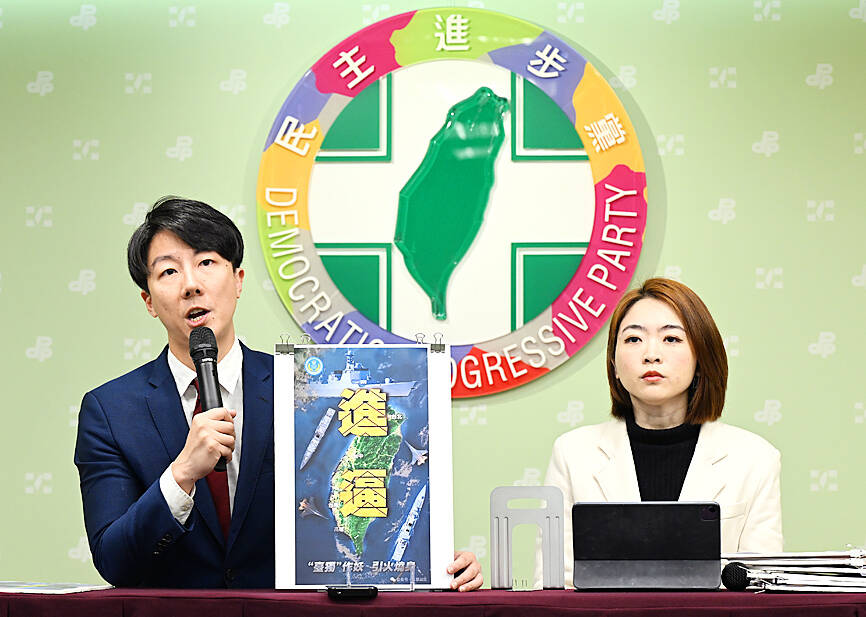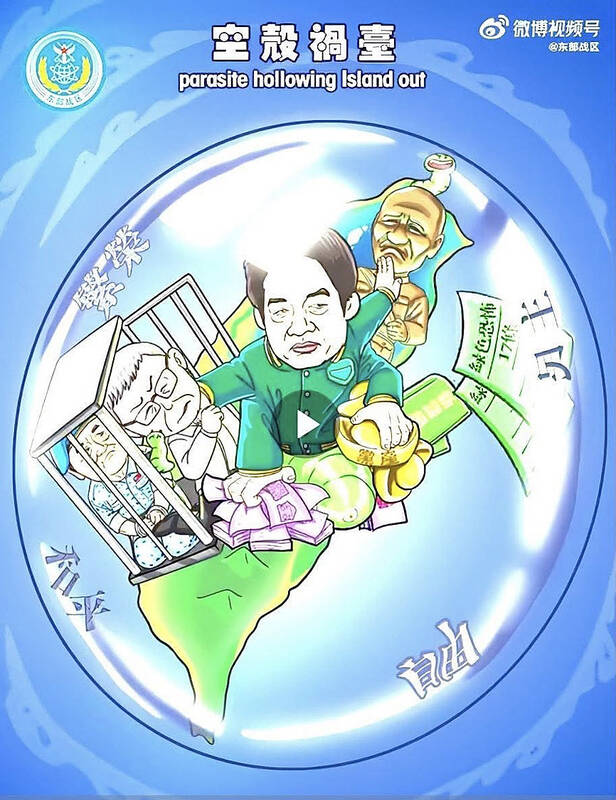The Chinese Nationalist Party (KMT) is maintaining close ties with Beijing, the Democratic Progressive Party (DPP) said yesterday, hours after a new round of Chinese military drills in the Taiwan Strait began.
Political parties in a democracy have a responsibility to be loyal to the nation and defend its sovereignty, DPP spokesman Justin Wu (吳崢) told a news conference in Taipei.
His comments came hours after Beijing announced via Chinese state media that the Chinese People’s Liberation Army’s Eastern Theater Command was holding large-scale drills simulating a multi-pronged attack on Taiwan.

Photo: Liao Cheng-hui, Taipei Times
Contrary to the KMT’s claims that it is staunchly anti-communist, KMT Deputy Chairman Andrew Hsia (夏立言) a day earlier visited top Chinese Communist Party (CCP) officials in Henan Province, Wu said, adding that Hsia did not condemn Bejing’s communism, saber rattling or disruption of regional peace, but instead voiced support for the so-called “1992 consensus.”
The “1992 consensus” — a term that former Mainland Affairs Council chairman Su Chi (蘇起) in 2006 admitted making up in 2000 — refers to a tacit understanding between the KMT and the CCP that both sides of the Taiwan Strait acknowledge that there is “one China,” with each side having its own interpretation of what “China” means.
Hsia’s failure to stand up to Beijing proved that claims of being anti-communist were just empty words by KMT Chairman Eric Chu (朱立倫) to placate voters, Wu said.

Photo: Screen grab from the Chinese Nationalist Party’s (KMT) Facebook page
Separately, the KMT, responding to the reports of China’s military drills, called on “the other side [of the Taiwan Strait] to lay down its arms” amid what it called “spiraling hostility across the two sides” brought about by the national security measures of the administration of President William Lai (賴清德).
The Lai administration should replace confrontation with dialogue and avoid war instead of provoking one, it added.
The KMT’s self-styled “2D strategy” — advocating “defense” and “dialogue” — is the best expression of patriotism and hope for defending Taiwan’s security, it said.

Photo: Screen grab from Sina Weibo
The party is to continue supporting military service salary and benefit increases as the foundation of national defense, it said.
Meanwhile, the Taiwan People’s Party (TPP) in a statement protested and condemned the actions of China’s Eastern Theater Command and the CCP’s threat to take Taiwan by force.
Beijing’s military actions conducted in the name of suppressing Taiwanese independence is an attack on all Taiwanese and international norms, the TPP said.
On the Eastern Theater Command’s release of propaganda, including an image showing Lai choking former Taipei mayor Ko Wen-je (柯文哲), the TPP’s founding chairman, and locking him in jail — linking its drills to Ko’s detention — the TPP said that Ko’s legal situation is not Beijing’s concern.
Taiwan is a democracy and uses the rule of law to resolve problems, it said, adding that the nation would not allow outside forces to sow division or meddle in its internal affairs.
The TPP supports efforts to bolster national defense and democratic resilience without forgoing the pursuit of diplomatic discourse to avoid further escalation of tensions across the Strait, it added.
Su Tzu-yun (蘇紫雲), a research fellow at the Institute for National Defense and Security Research, said that the drills are a response to new military strategies recently released by the US, which prioritize deterring a Chinese invasion of Taiwan.
Whenever the international community shows significant support for Taiwan, China uses military exercises to intimidate the nation, Su said.
With the downfall of He Weidong (何衛東), vice chairman of China’s Central Military Commission, and the disappearance of Eastern Theater Command Director Lin Xiangyang (林向陽), the Chinese military is also using the drills to control morale, Su said.
Additional reporting by Lin Che-yuan and Chen Yu-fu

A strong continental cold air mass is to bring pollutants to Taiwan from tomorrow, the Ministry of Environment said today, as it issued an “orange” air quality alert for most of the country. All of Taiwan except for Hualien and Taitung counties is to be under an “orange” air quality alert tomorrow, indicating air quality that is unhealthy for sensitive groups. In China, areas from Shandong to Shanghai have been enveloped in haze since Saturday, the ministry said in a news release. Yesterday, hourly concentrations of PM2.5 in these areas ranged from 65 to 160 micrograms per cubic meter (mg/m³), and pollutants were

Taiwan’s armed forces have established response protocols for a wide range of sudden contingencies, including the “Wan Chun Plan” to protect the head of state, the Ministry of Defense (MND) said today. After US President Donald Trump on Saturday launched a series of airstrikes in Venezuela and kidnapped Venezuelan President Nicolas Maduro, concerns have been raised as to whether China would launch a similar “decapitation strike” on Taiwan. The armed forces regularly coordinate with relevant agencies and practice drills to ensure preparedness for a wide range of scenarios, Vice Minister of National Defense Hsu Szu-chien (徐斯儉) told reporters before a

EVA Airways on Saturday said that it had suspended a pilot and opened an investigation after he allegedly lost his temper and punched the first officer several times as their plane was taxiing before takeoff at Los Angeles International Airport. According to a report published on Thursday by The Reporter, the incident occurred after the flight’s Malaysian first officer tried to warn the Taiwanese pilot, surnamed Wen (文), that he was taxiing faster than the speed limit of 30 knots (55.6kph). After alerting the pilot several times without response, the first officer manually applied the brakes in accordance with standard operating

The New Taipei City Social Welfare Department on Thursday celebrated Paralympic competitor Chen Tzu-wei (張孜維), who received last year’s national Golden Eagle award for exemplary achievement by Taiwanese with disabilities. Chen, who suffers from childhood-onset muscular dystrophy, did not attend the first award ceremony held by the Ministry of Health and Welfare in November due to illness. Chen was formally presented with the award at the department, where he gave thanks to government workers for supporting his education and livelihood, the department said in a statement. Chen was raised by the Ai-hsin Home for Persons with Disabilities in the city’s Bali District (八里)